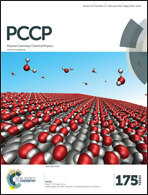Scope of negative solvatochromism and solvatofluorochromism of merocyanines†
Abstract
A vinylogous series of highly dipolar merocyanines were designed to study their solvatochromism in a wide range of solvents including low-polarity alkanes. It has been revealed that the lower vinylogues indeed have negative solvatochromism in the full range of solvent polarities starting from n-hexane, while the hexamethinemerocyanine exhibits reversed solvatochromism. With the extreme ranges of solvatochromism, the studied dyes possess 5–7 times weaker solvatofluorochromism, which can be rationalized via their decreased dipolarity in the fluorescent state. They also demonstrate an inverse dependence of their fluorescence quantum yield on solvent polarity and have near-record Stokes shifts in high-polarity media. The experimental data are supplemented by the results of DFT quantum chemical analysis of dye electronic structures in both the ground and excited states with PCM solvent field simulation.


 Please wait while we load your content...
Please wait while we load your content...